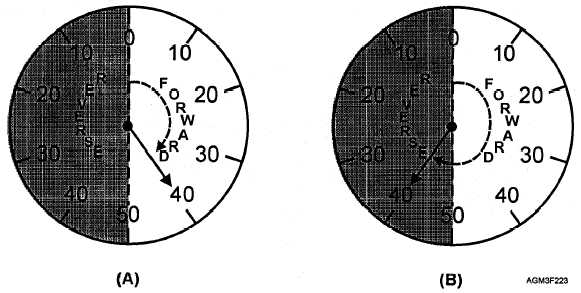Forward speeds are on the right half of the
speedometer, while reverse speeds are on the left.
Speeds of less than 50 mph are clear-cut
(unambiguous), and cause no confusion. However,
speeds of 50 mph or more are ambiguous and cause a
phenomenon known as velocity aliasing. Velocity
aliasing is a process that causes a Doppler radar to
display untrue velocity values because of the motion of
the target.
Consider the following scenario. A train departs
the station traveling forward at 40 mph (fig. 2-23, view
A). Beyond city limits, its cruising speed is increased
another 20 mph (fig. 2-23, view B). Suddenly
something is wrong! The speedometer reads 40 mph in
reverse. The train did not change direction; it has
simply exceeded the limits of its instrument. The
train’s speed appears aliased as 40 mph in reverse,
obviously an ambiguous velocity.
While radars don’t use speedometers, they do
measure phase shifts and experience velocity aliasing
in much the same way as the train. Consider the 360° of
one wavelength as the radar’s speedometer. When
phase shifts are less than 180° (one-half wavelength),
they are clearly detectable. However, shifts of 180° or
more are ambiguous. The radar is unsure if motion is
inbound toward the antenna at 60 knots, or outbound at
40 knots.
Look at figure 2-24. In views (A) and (B), the
target’s motion poses no problem to the radar as both
motions produce phase shifts of less than 180° (one-
half wavelength), regardless of direction. Illustration
(C) depicts a phase shift? of 180°. Here is where the
problems begin. Remember, that to unambiguously
measure the phase shift, the shift must be less than one-
half the wavelength (180°). In this case, we cannot
distinguish whether the 180° shift represents motion
toward or away from the radar. This measurement is
ambiguous. Illustration (D) depicts a phase shift of
270° resulting from energy striking a target that is
moving away from the radar. Since a shift of 270° is
more than one-half wavelength (180°), it is
ambiguous. This 270° shift is seen as a 90° phase shift
of motion toward the radar. This can result in an
aliased velocity being displayed.
While aliased velocities are subject to
misinterpretation, the WSR-88D has a unique way of
dealing with them. Computer programs are designed to
recognize that direction reversal is impossible. They
determine that wind speeds are exceeding radar
tolerance and calculate the amount of aliasing
occurring. All necessary corrections are then applied
to the products you receive.
Nyquist Velocity
As just explained, velocity detection is wavelength
dependent. As soon as the one-half wavelength limit is
passed, the determination of velocity becomes
ambiguous. Anytime we speak of wavelength, the
same arguments hold for frequency, since they are
inversely related. Ultimately, the pulse repetition
frequency (PRF) of a radar determines the maximum
speed that can be detected without confusion. The
maximum unambiguous velocity that can be detected
at a given PRF is called the Nyquist velocity. Nyquist
Figure 2-23.—(A) Speedometer showing true velocity. (B) Speedometer showing ambiguous velocity.
2-20

